Chevrolet Sonic Repair Manual: Transmission Replacement (With 1.2L or 1.4L Engine)
- Removal Procedure
-
- Remove the battery tray. Refer to Battery Tray Replacement.
- Without draining the coolant or removing the hoses, remove and position aside the radiator surge tank. Refer to Radiator Surge Tank Replacement.
- Remove the transmission range selector lever cable. Refer to Range Selector Lever Cable Replacement.
- Disconnect the control valve body transmission control module electrical connector (1) then unclip the connector from the transmission.
- Remove the transmission fluid cooler inlet hose from the transmission. Refer to Fluid Cooler Inlet Hose Replacement.
- Remove the transmission fluid cooler outlet hose from the transmission. Refer to Fluid Cooler Outlet Hose Replacement.
- Plug and/or cap the pipes and transmission to prevent contamination.
- Remove the upper transmission to engine bolts (1).
- Install the support fixture. Refer to Engine Support Fixture.
- Drain the transmission fluid. Refer to Transmission Fluid Drain and Fill.
- Remove the front exhaust pipe. Refer to Exhaust Front Pipe Replacement.
- Remove the front wheel drive shafts from the transmission. Refer to Front Wheel Drive Shaft Replacement.
- Remove the starter motor. Refer to Starter Replacement.
- Mark the relationship of the flywheel to the torque converter for reassembly.
- Remove the torque converter to flywheel bolts (1).
- Remove the drivetrain and front suspension frame. Refer to Drivetrain and Front Suspension Frame Replacement.
- Remove the rear transmission mount bracket from the transmission. Refer to Transmission Mount Bracket Replacement - Rear.
- Remove the left transmission mount (4). Refer to Transmission Mount Replacement - Left Side.
- Use a transmission jack in order to support the transmission.
- Remove the lower transmission nut (1) and the lower transmission bolts (2?).
- Separate the transmission from the engine.
- Lower the transmission with the transmission jack far enough to remove the transmission.
- Flush and flow test the transmission oil cooler and lines. Refer to Transmission Fluid Cooler Flushing and Flow Test.
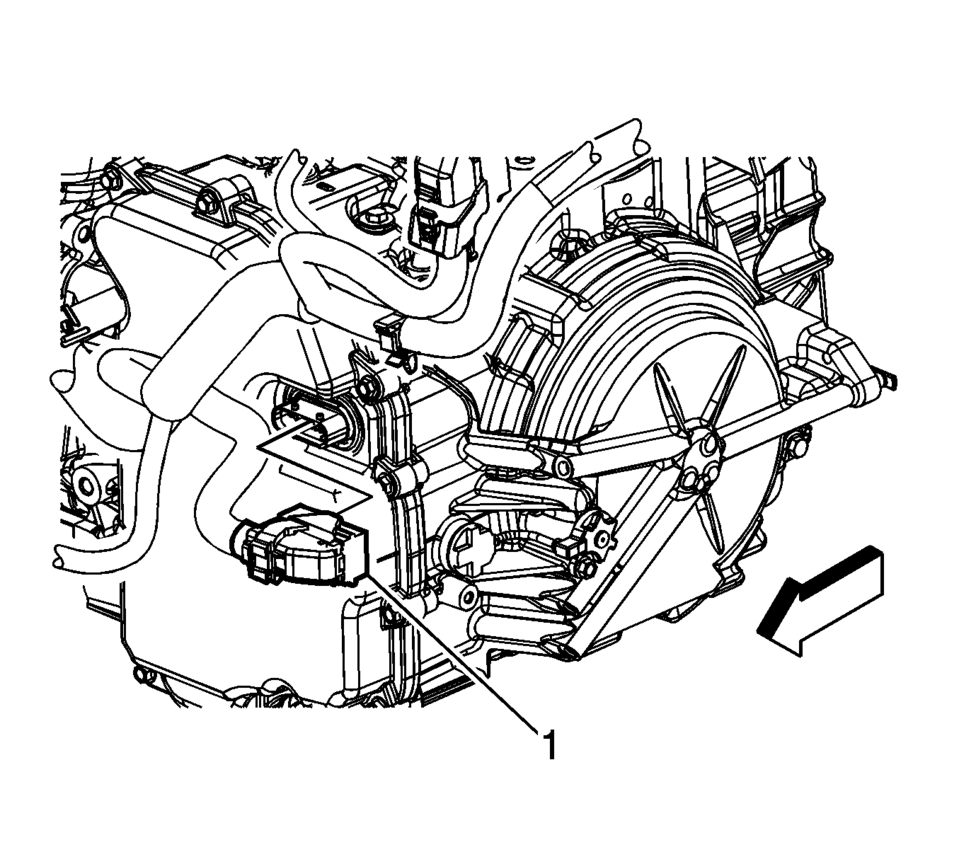
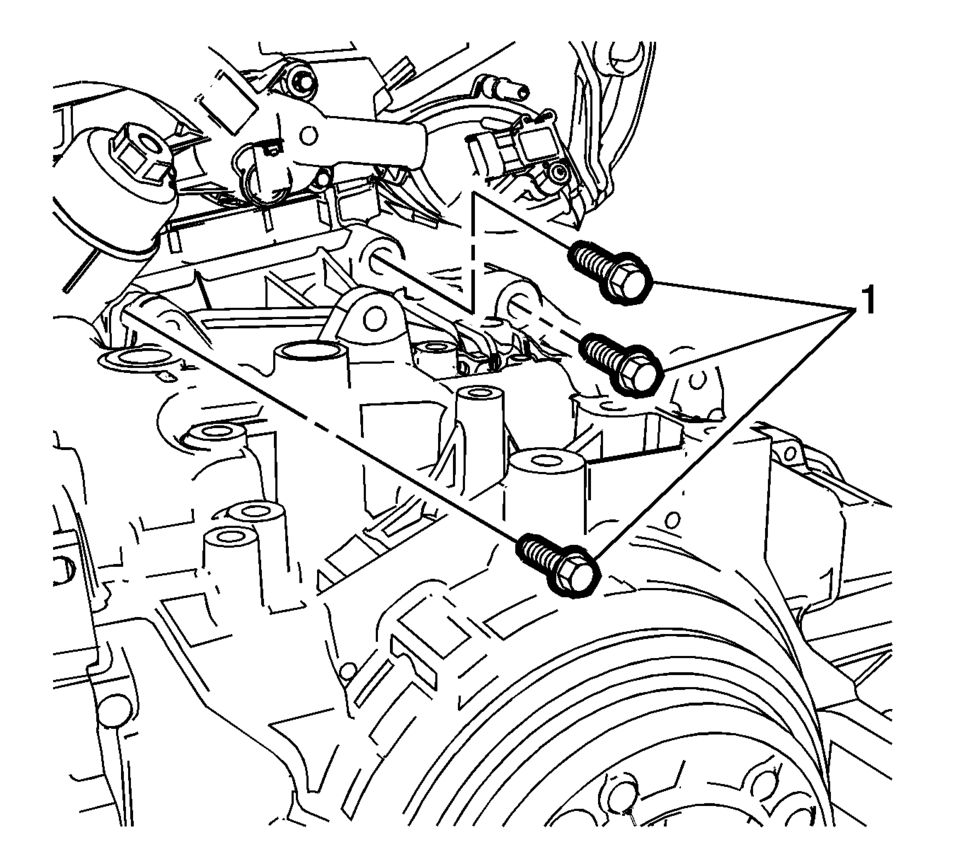
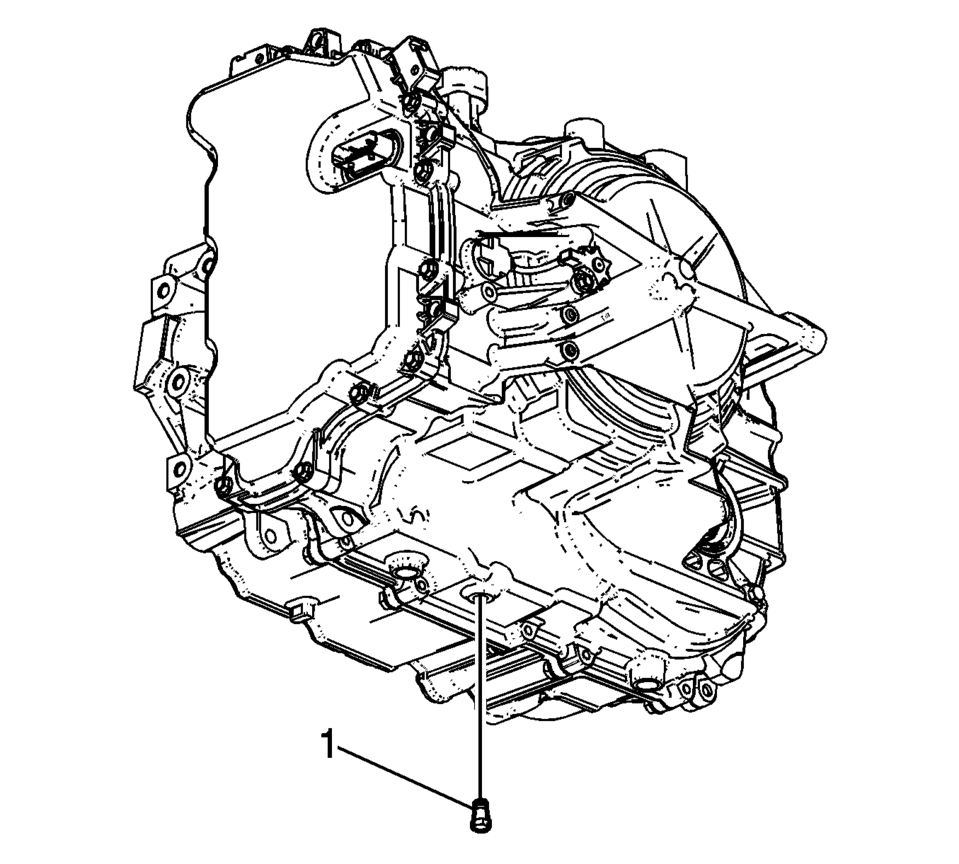
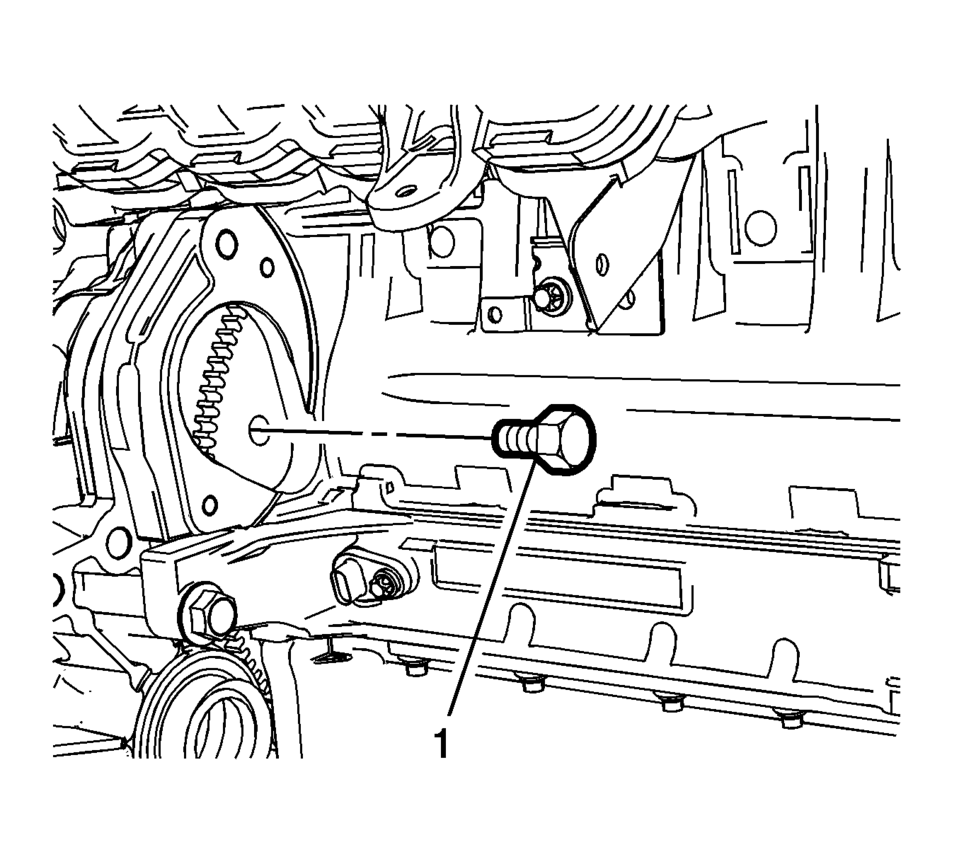
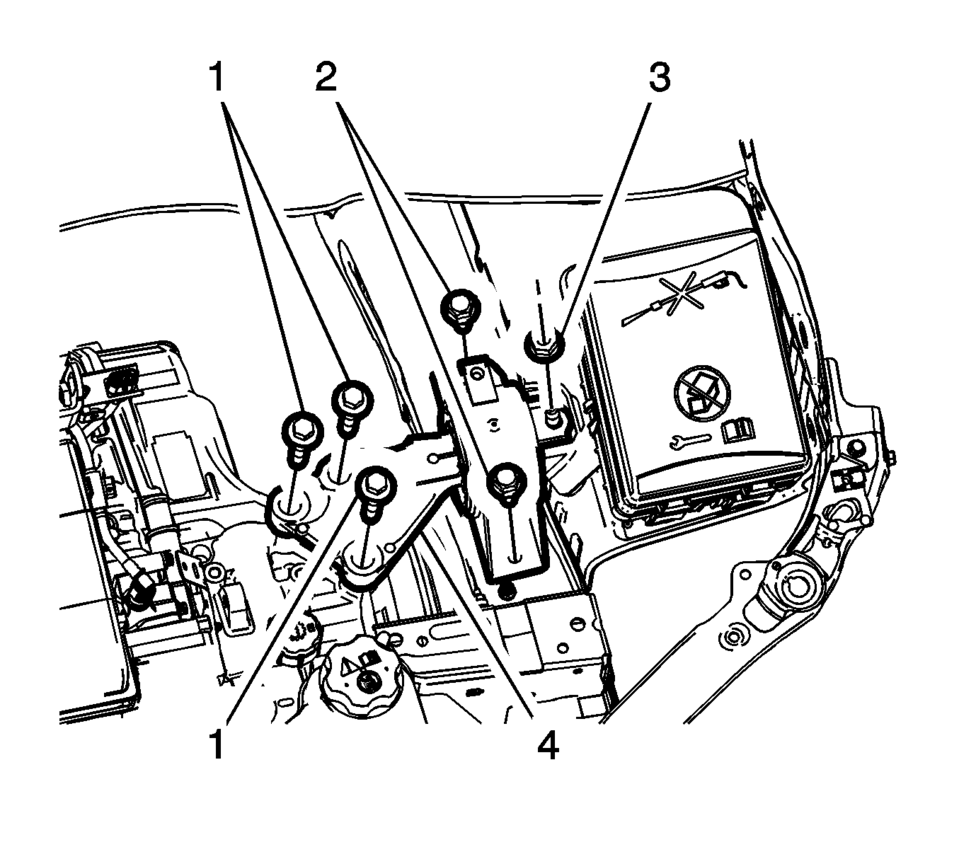
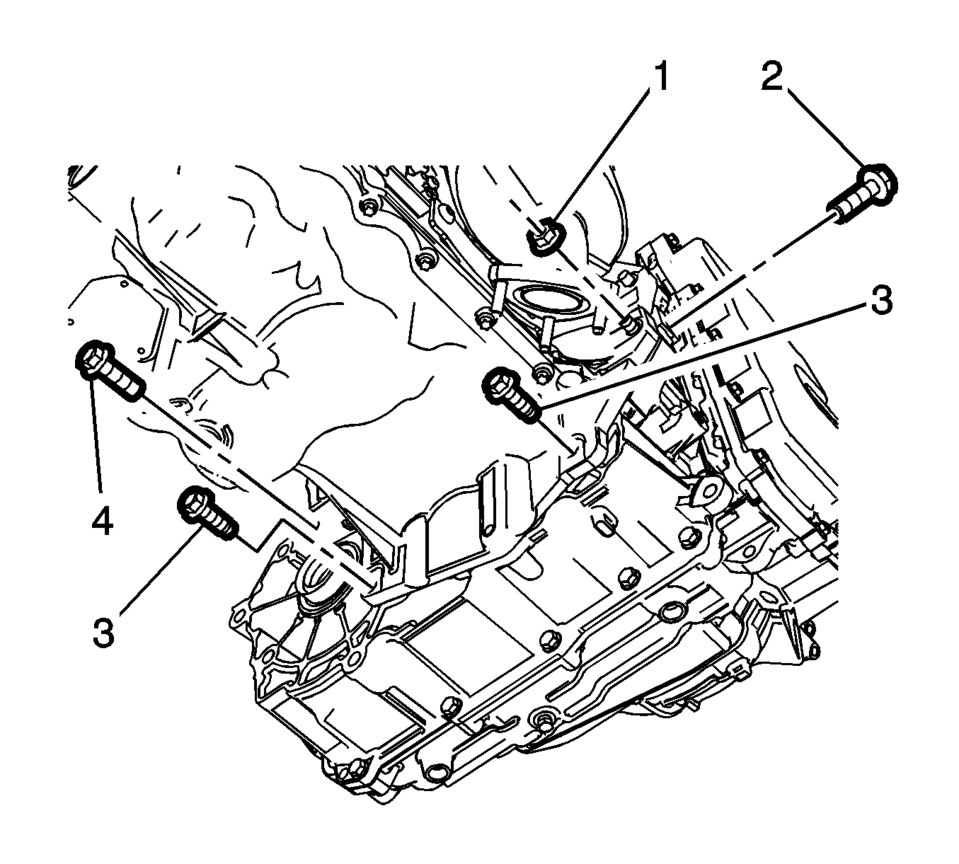
Note:
Ensure the torque converter remains securely in place on the transmission input shaft while separating and removing the transmission.
- Installation Procedure
-
- Raise the transmission with the transmission jack and position the transmission to the engine.
- Install the lower transmission bolts (2, 4) and tighten
to 60 Y (44 lb ft)
.
- Install the lower transmission bolts (3) and the lower
transmission nut (1) and tighten to 40 Y
(30 lb ft)
.
- Remove the transmission jack.
- Install the left transmission mount (4). Refer to Transmission Mount Replacement - Left Side.
- Install the rear transmission mount bracket to the transmission. Refer to Transmission Mount Bracket Replacement - Rear.
- Install the drivetrain and front suspension frame. Refer to Drivetrain and Front Suspension Frame Replacement.
- Install the torque converter to flywheel bolts (1)
and tighten to 60 Y (44 lb ft)
.
- Install the starter motor. Refer to Starter Replacement.
- Install the front wheel drive shafts to the transmission. Refer to Front Wheel Drive Shaft Replacement.
- Install the front exhaust pipe. Refer to Exhaust Front Pipe Replacement.
- Remove the support fixture. Refer to Engine Support Fixture.
- Install the upper transmission to engine bolts (1) and tighten to
60 Y (44 lb ft)
.
- Connect the control valve body transmission control module electrical connector (1) then clip the connector to the transmission.
- Install the transmission fluid cooler outlet hose to the transmission. Refer to Fluid Cooler Outlet Hose Replacement.
- Install the transmission fluid cooler inlet hose to the transmission. Refer to Fluid Cooler Inlet Hose Replacement.
- Install the transmission range selector lever cable. Refer to Range Selector Lever Cable Replacement.
- Adjust the automatic transmission range selector lever cable. Refer to Range Selector Lever Cable Adjustment.
- Install the radiator surge tank. Refer to Radiator Surge Tank Replacement.
- Install the battery tray. Refer to Battery Tray Replacement.
- Fill the transmission with fluid. Refer to Transmission Fluid Drain and Fill.
- If a NEW transmission control module (TCM) has been installed into the vehicle, the NEW module needs to be reprogrammed. Refer to Service Programming System (SPS).
- Transmission internal service/overhaul
- Valve body repair or replacement
- Control solenoid valve assembly replacement
- TCM software/calibration update
- Any service in response to a shift quality concern
- Perform the transmission adaptive values learn. Refer to Transmission Adaptive Values Learn.
- Road test the vehicle.

Caution:
Refer to Fastener Caution.


Note:
If reusing the torque converter bolts, clean the threads and apply threadlocker to the threads prior to installation.


Note:
The transmission adaptive values learn procedure must be performed when one of the following repairs have been made to the vehicle. Failure to perform the procedure after one of the following repairs may result in poor transmission performance, as well as transmission DTCs being set:
 Transmission Replacement
Transmission Replacement
Removal Procedure
Remove the battery and battery tray. Refer to
Battery Tray Replacement.
Disconnect the transmission range selector lever cable
terminal (1) ...
 Transmission Replacement (With 1.6L or 1.8L Engine)
Transmission Replacement (With 1.6L or 1.8L Engine)
Removal Procedure
Remove the battery tray. Refer to
Battery Tray Replacement.
Without draining the coolant or removing the hoses,
remove and position aside the radiator surge t ...
Other materials:
Front Seat Armrest Replacement
Front Seat Armrest Replacement
Callout
Component Name
1
Front Seat Armrest Cover Zipper
Procedure
Open the zipper to access the front seat armrest mounting bolt and to
remove the armrest cover
...
Differential Case Assemble
Special Tools
J-810721 Axle Shaft Seal Remover Support Base
R-0407011 Bearing Race Remover
R-0407012 Differential Carrier Cone Bearing Cap Driver
R-0007761 Universal Handle for Pullers and Installers
S-9407194 Speed Sensor Impeller Ring Installer
S-9407195 Pinion Gear Case Bearing I ...
Hydraulic Valve Lash Adjuster Replacement
Hydraulic Valve Lash Adjuster Replacement
Callout
Component Name
Preliminary Procedures
Remove the hydraulic valve lash adjuster arms. Refer to Hydraulic Valve
Lash Adjuster Arm Replacement.
1
H ...
0.0056
